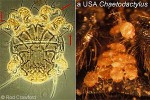Cook Islands Biodiversity Database
Species Page
Chaetodactylus ludwigi
Bee Hitch-hiker Mite
Multimedia & Additional Resources
| Type | Description | Download |
| a North American species | 57KB |
General Information
Cook Islands Distribution
| Southern Group: Present Makatea: | ||||||||
RR |
MG |
AT |
MK |
MT |
AK |
PL |
TK |
MN |
+++ |
+++ |
|||||||
| Northern Group: | |||||
TN |
MH |
RK |
PK |
NS |
SW |
Pests & Hosts
| Relationship | Hosts |
| Parasite - external | Megachile scutellata, |
Scientific Taxonomy
Chaetodactylus ludwigi (Trouessart, 1904)
TAXONOMY: ANIMALIA; ARTHROPODA; CHELICERATA; ARACHNIDA; Acarina; Acariformes; Astigmata; CHAETODACTYLIDAE
More Information
GENERAL NOTE: The USA images and the following notes are from: http://crawford.tardigrade.net/bugs/BugofMonth35.html The chaetodactylids are one of the mite families that have a special nymphal stage, called the hypopus, which is modified for phoresy (hitch-hiking on another organism without feeding on it). The hypopus has no head or mouthparts but has special structures for hanging on! With Chaetodactylus, these structures are giant claws on the first three pairs of legs. The hypopus of Chaetodactylus is 0.3mm long. The notes following are on Krombein's Hairy-footed Mite, Chaetodactylus krombeini (Chaetodactylidae), a native parasite and phoretic "hitchhiker" on the Orchard Mason Bee Osmia lignaria in America. "The female mite hitch-hikes [as a hypopus] on a bee to the nest, where it jumps off and makes itself at home in a larval cell. After it matures, it rapidly produces a small number of parthenogenic young that may feed as a parasite on the bee egg or larva, usually killing them. These mites then reproduce, some sexually, and begin to feed on the bee hosts' pollen ball. The population grows explosively, and within a few months can turn the bee food into a solid writhing mass of mites. You may open a mason bee nest and find such a mass any time from midsummer through the following spring. In the mass are various developmental stages and both sexes, although mostly females. The female has two pink sclerites on her dorsum, which gives groups of the adult mites a pinkish tinge. She also has two long setae on the hind tarsus, whence the common name." As bees emerge from the infested nest, they may crawl through an infested cell. When they do, they instantly acquire an overload of hitch-hiking mites in the hypopus stage, often enough to cripple the bees from flight. The mites at this stage [since they lack mouthparts] do not feed on the bee. Among the mites remaining in the nest are encysted individuals which look like pearly eggs and are found in small cracks or other hideaways. These apparently wait until later in the season before before emerging to re-infest a new nest in the same cavity, made by either another BOB or a related species. We don't know much about the cysts. [They are actually a second, sedentary type of hypopus with reduced legs.] The mites therefore kill host bees at two stages, egg or early larva and adult, because of completely different activities. We currently have no method of managing the mites, although keeping BOBs in paper tube inserts is helpful because it allows heat sterilization of the wooden block (to kill cysts) in the winter after the nests have been removed. Also, the tubes can be cut open to survey for the mites, which eventually may facilitate mite control. BOBs kept in bare wood blocks are basically helpless against this pest.
Vouchers & References
Vouchers:
Rarotonga: specimens on Lithurgus scabrosus, Arorangi upper beach, 2004/9, M.Kuhlmann, in 2006 paper as Chaetodactylus ludwigi. Mangaia: specimens on Lithurgus scabrosus, Ivirua on makatea 30m elev., 2004/9, M.Kuhlmann, in 2006 paper as Chaetodactylus ludwigi.
References:
Special Reference: Kuhlmann, M. (2006) Fauna and Biogeography of the Bees and Wasps of the Cook Islands (Hymenoptera Aculeata), J. Hym. Res. 15(1):26-37.
Data Update History (information):
zTX, zB06a, zM06a
Web Resources
Citation Information
McCormack, Gerald (2007) Cook Islands Biodiversity Database, Version 2007.2. Cook Islands Natural Heritage Trust, Rarotonga. Online at http://cookislands.bishopmuseum.org. ![]()
Please refer to our use policy.

